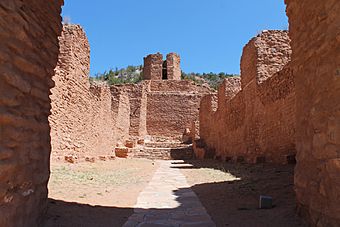Jemez Historic Site facts for kids
|
San José de los Jémez Mission and Gíusewa Pueblo Site
|
|

Nave of the San José de los Jémez Mission Church
|
|
| Location | NM 4, Jemez Springs, New Mexico |
|---|---|
| Area | 6 acres (2.4 ha) |
| Built | 1621 |
| Architect | Fr. Gerónimo Zárate Salmerón |
| Architectural style | Pueblo |
| NRHP reference No. | 73001147 |
Quick facts for kids Significant dates |
|
| Added to NRHP | March 14, 1973 |
| Designated NHL | October 16, 2012 |
The Jemez Historic Site is a special place in Jemez Springs, New Mexico. It used to be called the Jemez State Monument. This site protects the old buildings of the Native American Gíusewa Pueblo from the 1500s. It also preserves the Spanish mission called San José de los Jémez from the 1600s.
This important site was added to the National Register of Historic Places in 1973. Later, in 2012, it became a National Historic Landmark. The Jemez people, who live nearby, consider this place to be where their ancestors lived long ago.
Contents
Exploring the Jemez Historic Site
The Jemez Historic Site is found north of Jemez Springs village. It sits in the beautiful Jemez River valley. You can find it on the east side of New Mexico State Road 4.
What You Can See at the Site
The site covers about 6 acres (2.4 hectares) of land. It holds the remains of both a Native American pueblo and a Spanish mission. A pueblo is a type of village built by Native American people in the Southwest.
The Mission Church Remains
The most important part of the mission is the old church walls. These walls are about 110 feet (34 meters) long. This makes it one of the biggest mission churches from the 1600s in New Mexico. The church walls are mostly made of limestone. Some parts also use sandstone and volcanic tuff, which is a light rock made from volcanic ash.
The walls were once covered in traditional mud plaster. Some work has been done to protect the tops of the walls. This helps stop them from wearing away. At their bottom, the walls are very thick, about 6 to 7 feet (1.8 to 2.1 meters) wide.
Other Spanish Buildings
Near the church, you can see the foundations of other buildings. One was likely where the priest lived. Another Spanish foundation might have been a community building. South of the church, there is a small open area called a plaza. This plaza also has a cemetery.
The Gíusewa Pueblo Village
Next to the mission are the remains of a medium-sized pueblo. It had an estimated 200 rooms, divided into five main sections. This pueblo also included two kivas. A kiva is a special room used by Pueblo people for ceremonies and community gatherings.
The kivas at this site are square or rectangular. This is different from the round kivas found in some other places. Parts of the pueblo have been dug up and are open for visitors to see. Other parts have been covered back up or plastered. This helps protect them from weather damage.
A Look Back at History
The Gíusewa Pueblo was likely built in the late 1400s. Spanish explorers first wrote about it in 1581.
The Mission's Beginnings
A small mission was probably started next to the pueblo in 1598. However, the church buildings you see today were begun in 1621. The church was finished in 1623. But it was damaged by fire soon after. More work was done on it in 1625 and 1626.
For a while, there wasn't a priest living there all the time. Franciscan friars tried many times to teach the Pueblo people about their religion until about 1639. The Jémez people continued to live in the pueblo. They even built a square kiva inside the mission area.
The Pueblo Rebellion and Abandonment
The pueblo was left empty in 1680. This was when the Jémez people joined the Pueblo Rebellion. This rebellion forced the Spanish out of the region. The Spanish did not return until 1692. Over time, nature caused the buildings to fall apart. The church roof collapsed, and parts of its walls fell down.
Preserving the Past
Major digging to uncover the ruins began in 1910 and 1922. At that time, people started to make the buildings stable. The state of New Mexico bought the land then. In 1935, it was named a state monument. Today, it continues to teach us about the past.
Images for kids
See also






